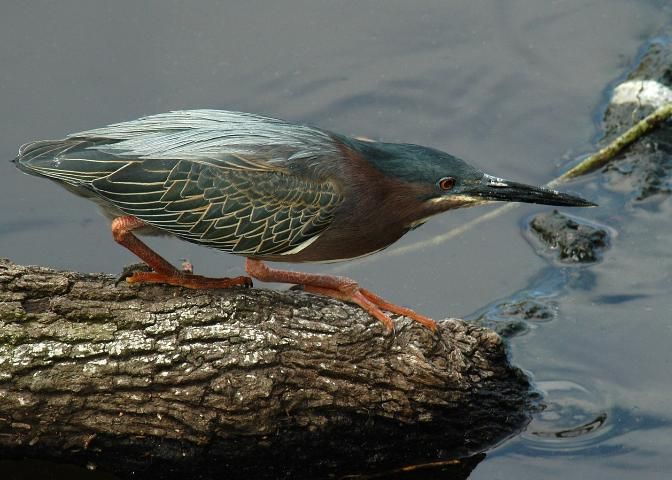
Credit: Lawrence Korhnak
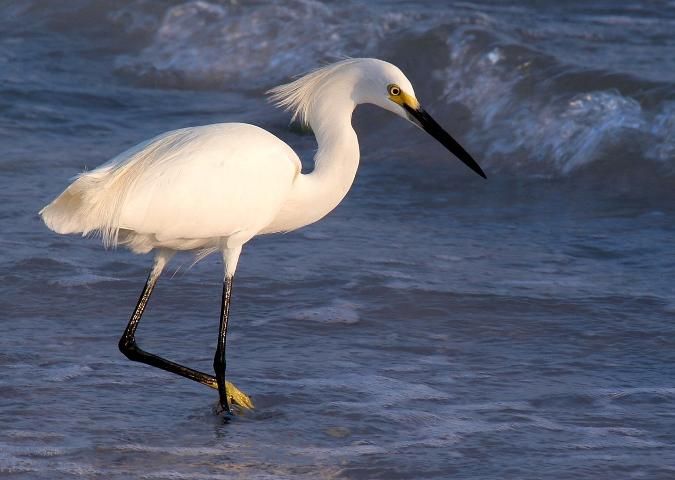
Credit: Lawrence Korhnak
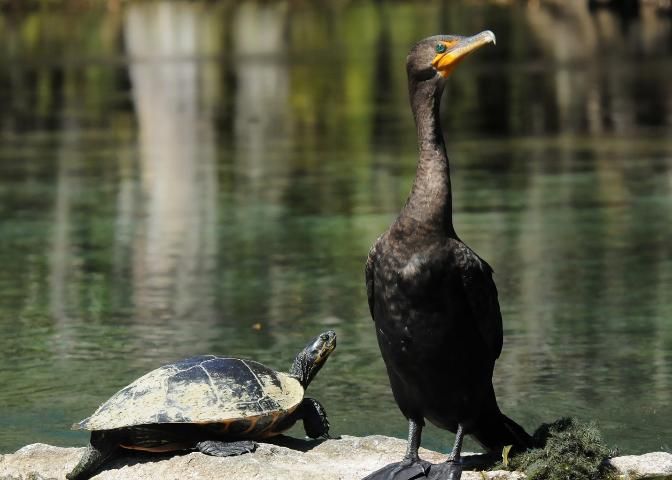
Credit: Lawrence Korhnak
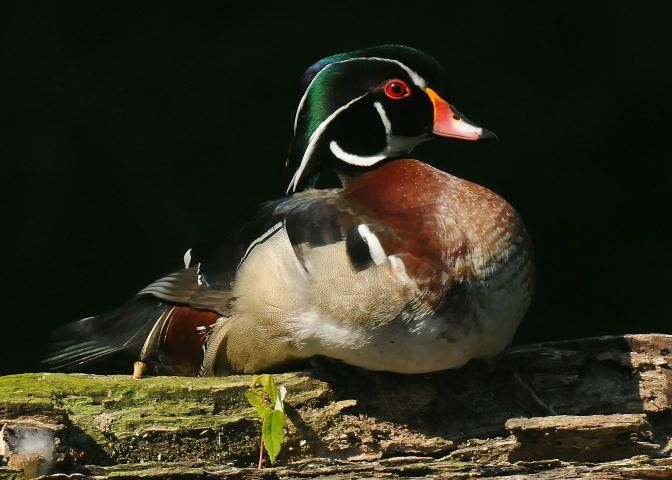
Credit: Lawrence Korhnak
Mark Hoyer
UF/IFAS
School of Forest, Fisheries, and Geomatics Sciences, Program in Fisheries and Aquatic Sciences
Florida LAKEWATCH
7922 NW 71st Street
Gainesville, Florida 32653-3071
Phone: 352/392-4817
E-mail: lakewat@ufl.edu
Web address: https://lakewatch.ifas.ufl.edu
The purpose of this information circular is to briefly describe Florida LAKEWATCH and LAKEWATCH's volunteer aquatic bird monitoring program. It will use current research information to describe how aquatic birds are related to the morphometry, water chemistry and aquatic plants in lake systems. Finally, it will identify and describe some characteristics of the most common aquatic birds observed on lake systems by Florida LAKEWATCH volunteers as they participated in LAKEWATCH's aquatic bird surveys (https://lakewatch.ifas.ufl.edu/media/lakewatchifasufledu/for-volunteers/Florida-LAKEWATCH-Aquatic-Bird-Survey-1-14-2021.pdf). Before you begin, however, we encourage you to peruse the following LAKEWATCH information circulars to obtain a more comprehensive understanding of how Florida's aquatic systems function:
Circular 101: A Beginner's Guide to Water Management—The ABCs
Circular 102: A Beginner's Guide to Water Management—Nutrients
Circular 103: A Beginner's Guide to Water Management—Water Clarity
Circular 104: A Beginner's Guide to Water Management—Lake Morphometry
Circular 105: A Beginner's Guide to Water Management—Symbols, Abbreviations & Conversion Factors
Circular 106: A Beginner's Guide to Water Management—Bacteria
Circular 107: A Beginner's Guide to Water Management—Fish Kills
Circular 108: A Beginner's Guide to Water Management—Color
Circular 109: A Beginner's Guide to Water Management—Oxygen and Temperature
Circular 110: A Beginner's Guide to Water Management—Fish Communities and Trophic State in Florida Lakes
Circular 111: A Beginner's Guide to Water Management—Aquatic Plants in Florida Lakes
Circular 112: A Beginner's Guide to Water Management—Muck: Causes and Corrective Actions
These publications can be downloaded free from the Florida LAKEWATCH website: https://lakewatch.ifas.ufl.edu/extension/information-circulars/.
Florida LAKEWATCH and Volunteer Aquatic Bird Surveys
Florida LAKEWATCH is a citizen scientist water quality monitoring program in Fisheries and Aquatic Sciences, a program in the School of Forest Resources and Conservation, in the University of Florida Institute of Food and Agricultural Sciences (UF/IFAS).
In 1991, LAKEWATCH was established by the Florida Legislature (Chapter 91-69; s. 240.5329, F.S.; now F.S. 1004.49) as Florida's volunteer water quality monitoring program (Hoyer et al. 2014). Since then, Florida LAKEWATCH has collected reliable water quality data on over 2,700 aquatic systems including lakes, dune lakes, estuaries, streams/rivers, and springs in 57 of Florida's 67 counties. LAKEWATCH has also worked with thousands of volunteers, educating them and showing them how to be good stewards of Florida's aquatic resources. This is the most comprehensive and longest-running water quality data source in the country, if not the world.
In 2012, LAKEWATCH and FDEP (Florida Department of Environmental Protection) completed a comparison study between the sampling protocols used by these two groups and found no significant difference between LAKEWATCH's volunteer-collected data and professionally collected QA/QC (quality assurance/quality control) data (Hoyer et al. 2012). In 2019, FDEP conducted a full laboratory audit on the LAKEWATCH laboratory finding all data produced in the laboratory to be of high quality. These studies demonstrate that volunteer-collected data are suitable for FDEP's regulatory decisions and for use by other state and local agencies for management actions.
Since the inception of Florida LAKEWATCH, there has also been a desire to survey aquatic bird use of Florida's lakes. A considerable number of bird species are known to use lakes, but few studies have directly quantified their numbers or examined long-term trends in diversity and abundance. For our purposes, aquatic birds will be defined as "all bird species that regularly use any type of aquatic or shoreline habitat." As Florida's wetlands continue to be altered or reduced in size, the importance of lake habitat to aquatic bird communities needs to be documented. Monitoring the distribution and abundance of birds associated with Florida lakes will help us determine which bird species use Florida lakes, and knowing that information will help us develop future management strategies. Thus in the late 1990s, LAKEWATCH put out a call to the citizen scientists already actively sampling water quality to see if any would be interested in counting birds on their lakes.
Volunteer bird-monitoring programs are by no means a new idea. There are many successful state and national programs, including the Christmas Bird Count (CBC) and the Breeding Bird Survey (BBS). Started in 1900 in response to the excessive hunting of birds, the CBC now has roughly 45,000 participants across the United States, Canada, Central America, and South America. Conducted annually, the CBC is the "oldest and largest wildlife survey in the world" (Butcher 1990). Likewise, the BBS, started in 1966, is a large-scale, roadside survey of North American birds. Currently there are over 3,500 routes across the United States and Southern Canada that are surveyed every June by experienced birders (Newson et al. 2005). Closer to home, a collaboration between the LAKEWATCH program leader and one of our volunteers sampling Lake Alto has led to a scientific publication in the international journal Lake and Reservoir Management (Hoyer et al. 2001) showing that volunteer bird-monitoring efforts can provide research quality long-term information on the status of aquatic bird populations.
The value of volunteer assistance cannot be stressed enough because it is the essence of the Florida LAKEWATCH program and other citizen-scientist programs. Volunteers are the most practical way to efficiently gather data on birds that use Florida lakes. Citizen volunteers can provide a more comprehensive and intimate understanding of these lake systems than could ever be achieved by biologists who visit lakes only one or two times. Over the long term, such monitoring efforts help us detect changes in the types and numbers of birds using lakes. Changes in bird populations could be an indication of natural or human-caused environmental factors at the local or state level. By encouraging volunteers to help, we hoped to empower citizens to take an active role in the management and conservation of their natural resources.
LAKEWATCH volunteers have now counted birds on almost 120 Florida lake systems located in 25 different counties with monthly counts for 1 to 17 consecutive years. The counts were conducted using the following methods developed by LAKEWATCH staff for earlier aquatic bird research (Hoyer and Canfield 1990, 1994a):
For the purposes of this LAKEWATCH circular, most bird counts were conducted by slowly boating once around the edge of an individual lake while counting all aquatic birds that were observed. Although LAKEWATCH preferred that surveys be conducted from a boat, some standardized bird surveys were performed from the shoreline areas and/or local docks.
Ideally, monthly surveys would be conducted between 9:00 a.m. and 12:00 noon on days with no rain and low winds, but some were conducted when volunteers had available time to conduct surveys. Volunteers recorded both the start and finish times of the survey, so the number of birds could be standardized by hour of counting time (number of birds/hour). Bird counts were also standardized according to the surface area of the lake that was being surveyed (number of birds/lake area).
We recommended that whenever possible two people conduct the bird survey together. With one person driving the boat, the other person could then devote their full attention to counting the birds. This method results in a more accurate survey when compared with a survey done by one person driving and counting at the same time.
It was important to avoid counting the same bird more than once. Often birds flush from their position when disturbed and fly ahead of the boat, landing along a portion of the shoreline that has not yet been surveyed. Whenever this happened, counters made a mental note of the birds' new locations and did not count them when passed a second time. To get accurate counts of large flocks, counters broke the flocks down into groups of 10 or 20.
All data were submitted to LAKEWATCH, and staff maintained an aquatic bird data set that corresponded to water chemistry data that had already been collected for each individual lake.
If you are just getting interested in watching birds, there are many hard-copy field guides to help identify birds in the field. These guides have a wealth of information on how to identify birds and information about the distribution/range of species and life history/ecology of individual species. The following are two of the most used field guides that LAKEWATCH can recommend for those interested in joining the millions of current birders and starting the hobby of watching birds:
- National Geographic Field Guide to the Birds of North America—Because of its excellent artwork and comprehensive coverage, the National Geographic guide remains the favorite of many serious birders. Its compact size and relatively light weight make it the best guide to take on a hike.
- The Peterson Field Guide series book A Field Guide to the Birds East of the Rockies—Roger Tory Peterson invented the modern field guide when his book A Field Guide to the Birds of Eastern and Central North America was released in 1934. Though newer guides have surpassed Peterson in usefulness and presentation, the colorful, lively artwork included evokes an unmatched love of birds and birding. Audubon released an enlarged and updated version in 2008, but at heart, it's still the same guide you used to find on your grandparents' shelf.
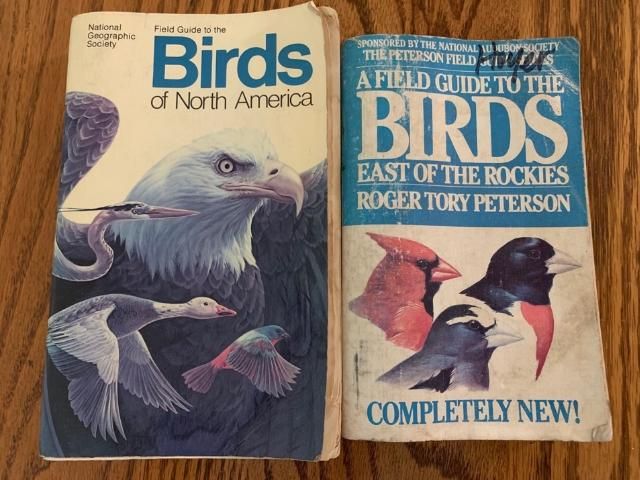
Credit: Mark Hoyer
The migration of bird guide books to mobile apps has been a revelation for birders. What was once a hefty tome can now easily slip into a pocket. Even more helpful, species accounts can now be accompanied by actual audio of bird vocalizations, an overwhelming improvement on the phonetic text (e.g., "a gentle, rolling popopopo"). In addition to simply digitizing traditional guides, mobile technology offers birders new options for recording observations and for identifying mystery sounds. The following are a few of many apps for bird-watching that LAKEWATCH can recommend:
- Audubon Birds Guide: North America
- The Sibley eGuide to Birds
- iBird
- Merlin Bird ID by Cornell University
Aquatic/Water Birds
Birds that live at least part of their lives in or around water are referred to as aquatic birds and/or water birds. Each species has specific requirements that must be met for the birds to be born, grow, survive to adult size, and reproduce to maintain the species over time. Thus, it can be challenging to make broad statements that apply to all aquatic birds. Aquatic birds are often grouped into subclasses based on habitat preference, which permits generalizations to be made about birds with similar requirements. For example, waterfowl, marsh birds, shorebirds and wading birds are groups of aquatic birds that use similar habitats.
Waterfowl is the umbrella term for ducks, geese, and swans. Waterfowl are strong swimmers with medium to large bodies. They have historically been an important human food source, and continue to be hunted as game, or raised as poultry for meat and eggs. The domestic duck is sometimes even kept as a pet.
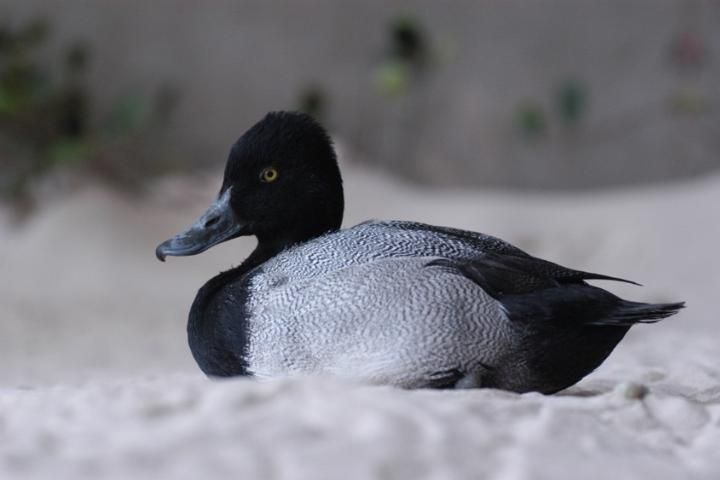
Credit: Lawrence Korhnak
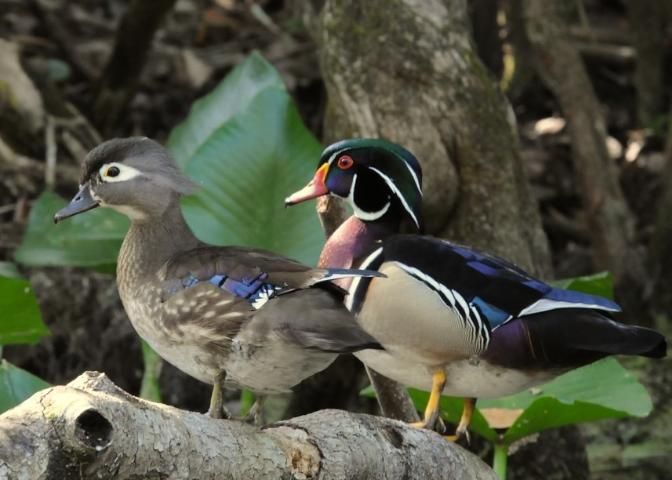
Credit: Lawrence Korhnak
Marsh birds live in or around marshes (treeless, wet tracks of grass, sedges, cattails and other herbaceous wetland plants) and swamps (areas of wet, soft, low, water-saturated land that is dominated by trees and shrubs). This is a broad category that includes many unrelated species of birds, all of which prefer to nest and/or live in marshy, swampy areas. Marsh birds include herons, storks, flamingoes, limpkins, and rails.
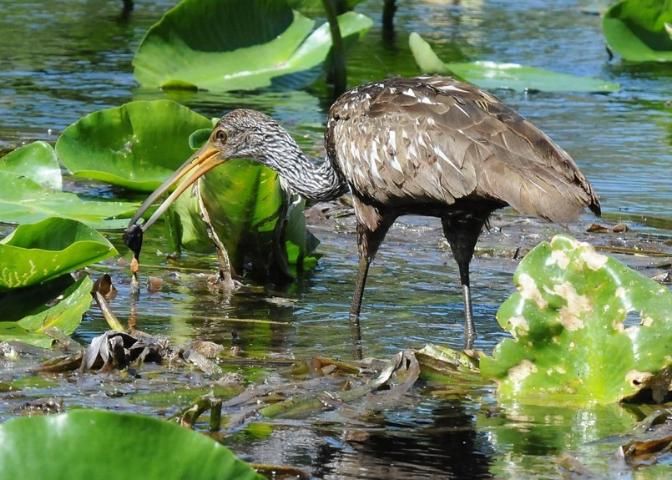
Credit: Lawrence Korhnak
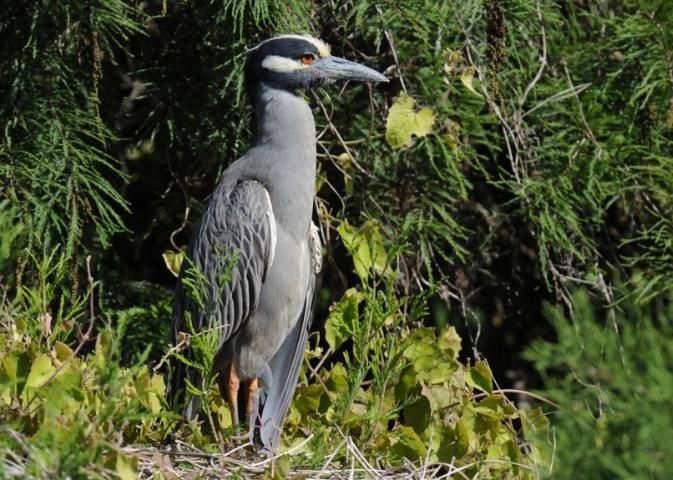
Credit: Lawrence Korhnak
Shorebirds inhabit open areas of beaches, grasslands, wetlands, and tundra. These birds, which include plovers, oystercatchers, avocets, stilts, and sandpipers, are often dully colored and have long bills, legs, and toes.
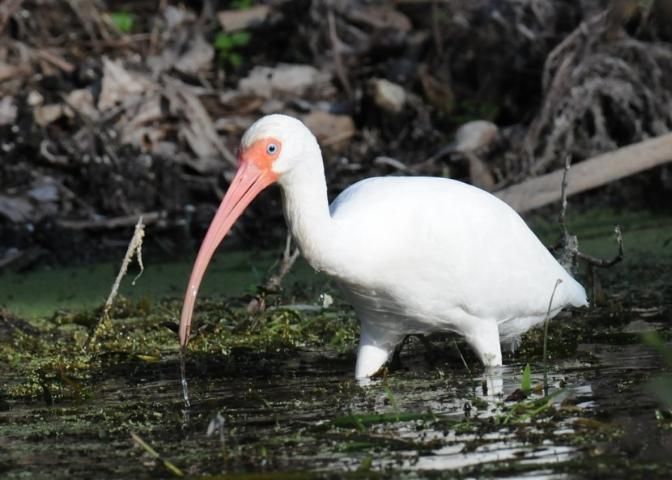
Credit: Lawrence Korhnak
Wading birds generally do not swim or dive for prey, but instead wade in shallow water to forage for food that is not available on shore. Wading birds include herons, egrets, spoonbills, cranes, stilts, avocets, curlews, and godwits. These birds generally have long legs, long bills and short tails, which allows them to strike and/or probe under the water for fish, frogs, aquatic insects, crustaceans, and other aquatic fauna.
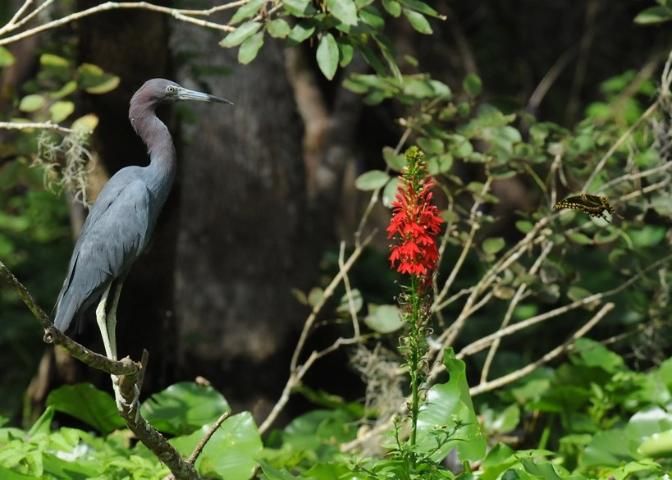
Credit: Lawrence Korhnak
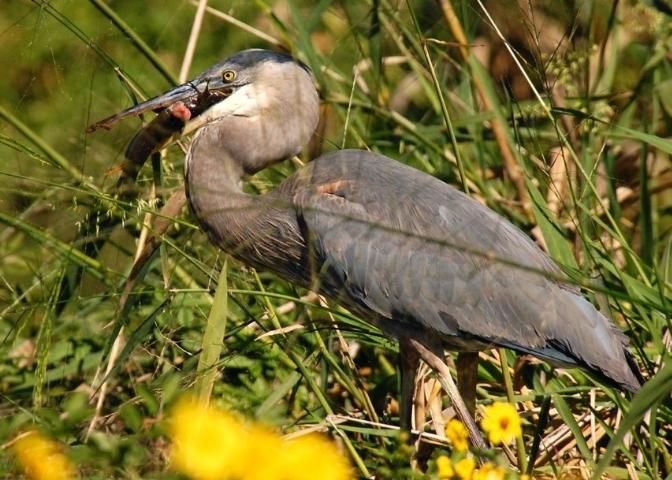
Credit: Lawrence Korhnak
Some birds can fall into one or more of these general groups, so care should be taken when interpreting/making statements applied to generalized groups. These classifications group birds based on habitat preference, but birds are complex and adaptable animals. Thus, regardless of habitat, it may be possible to observe many aquatic bird species from different classification groups in the same habitat if adequate food resources are available for the individual species.
Aquatic/Water Birds—Lake Systems
Birds are an integral part of all lake systems, but their role in the ecology of lakes has frequently been overlooked. This is surprising because aquatic birds are often the first wildlife that is seen when visiting a lake, and the vast majority of people who visit lakes enjoy the beauty and grace of aquatic birds. However, the majority of earlier research and management conducted on lake systems involved nutrient enrichment problems and aquatic plant management. The focus of this early research was primarily to provide potable water, flood control, navigation, and recreational boating, swimming, and fishing. Consideration was seldom given to aquatic bird communities that used these lakes. As a result, little information was available regarding how these different lake management activities might affect aquatic bird communities.
This situation began to change rapidly in the 1980s when many ornithologists (scientists studying birds) and limnologists (scientists studying freshwater systems) became increasingly conscious of the importance of birds to aquatic systems (Kerekes and Pollard 1994; Hanson and Kerekes 2006). These researchers have worked together to identify many significant relationships between lake limnology and aquatic bird populations. This research can be used to predict the impact some lake management programs may have on aquatic bird communities and birds on lake management strategies. Birds can be a major contributor of nutrients to a water body. Currently, international meetings are held on a regular basis to examine the role of aquatic birds in the ecology of aquatic systems and to develop information useful to lake management personnel.
Aquatic/Water Birds—Lake Area and Bird Species Richness
There is a strong relationship between aquatic bird species richness (the number of bird species in an aquatic community) and the surface area of the lake they inhabit. Many studies have shown that plant and animal species richness increased as habitat area increased. Most researchers and lake managers agree that larger areas are more likely to include diverse habitats that provide more species niches. This aquatic bird species richness versus lake area relationship is currently being used by Southwest Florida Water Management District to help determine minimum lake levels for lakes in their district (Leeper et al. 2001).
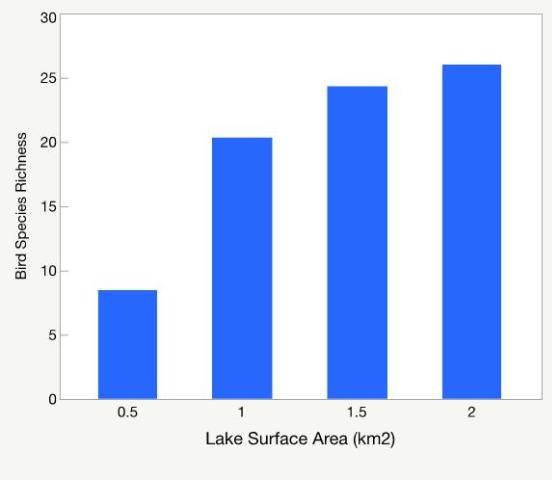
Credit: Hoyer and Canfield (1994a)
Aquatic/Water Birds—Lake Trophic State and Bird Abundance
Lake trophic state is the degree of biological productivity of a water body. Biological productivity is exemplified by the quantity of algae, aquatic plants, fish, and wildlife that a water body can produce. The following classifications range from low biological productivity to high biological productivity: oligotrophic, mesotrophic, eutrophic, and hypereutrophic (see LAKEWATCH information Circulars 101 and 102). The level of trophic state is usually set by the background nutrient concentrations determined by the geology in which the lake lies. Nutrients (primarily phosphorus and nitrogen) are the most common factors limiting growth of algae and aquatic macrophytes that form the base of the biological food chain. It is therefore not surprising that lakes with higher trophic states generally support more aquatic birds (Hoyer and Canfield 1994a), because these lakes usually have an abundance of aquatic plants and animals that can be used for food and shelter by aquatic birds.
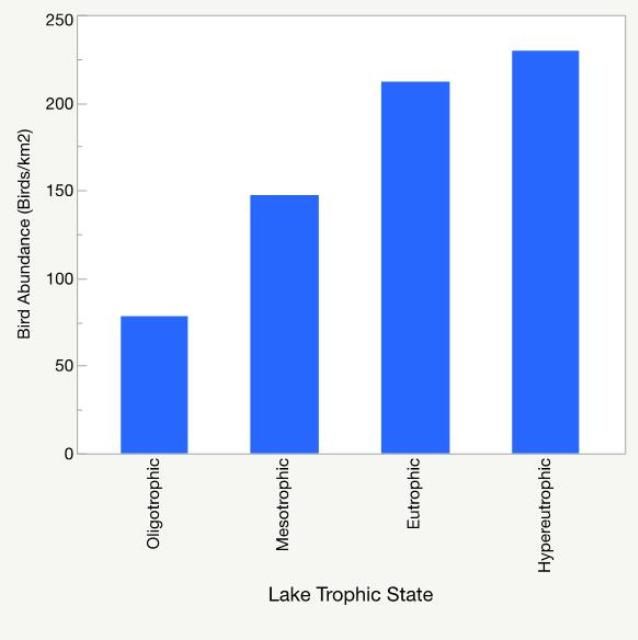
Credit: Hoyer and Canfield (1994a).
Some lake managers question whether aquatic birds show up because a lake is productive or whether the lake becomes productive because birds bring nutrients to the system. There have been instances where large flocks of birds, such as geese, that feed on terrestrial agricultural grains and then roost on a lake, ultimately cause elevated nutrient concentrations in a lake. However, most current research suggests that the majority of aquatic bird communities extract nutrients from the lake and function more as nutrient recyclers than as nutrient contributors/loaders (Hoyer and Canfield 1994a).
Most lake management efforts are directed toward the manipulation of lake trophic state, with most resources focused on reducing nutrients caused by anthropogenic activities. However, management agencies in some areas will actually add fertilizer (nutrients) in an attempt to increase productivity of plants, algae, and fish, which increases angling activities. In either case, changes to the trophic state of a lake system will have corresponding impacts on the aquatic birds that use the lake. If aquatic birds are an important component of an individual lake, this relationship needs to be considered before nutrient reductions or additions occur.
Aquatic/Water Birds—Aquatic Plants and Bird Communities
Both algae and larger aquatic plants contribute to the basic productivity of lake systems and support the food chain for aquatic birds. Many aquatic birds rely on larger aquatic plants to meet a variety of needs during their life cycles. Some birds nest directly in aquatic plants. Others use plants as nesting material, forage among them for food, or use plants as resting platforms for refuge from predators. Some species of birds eat aquatic plants directly; some eat invertebrates that live attached to aquatic plants. Because there are so many associations between aquatic birds and aquatic plants, it would be reasonable to expect a strong relationship between the abundance of all aquatic birds and the abundance of aquatic plants in a lake system. However, multiple studies have found no such relationship after accounting for differences in lake productivity. This surprising lack of relationship between total bird abundance and total aquatic plant abundance can be explained by the fact that individual bird species require different types and quantities of aquatic plants. Florida LAKEWATCH research (Hoyer and Canfield 1994a) has suggested that aquatic bird species can be loosely divided into three general groups: 1) birds that are detected more often in relation to an abundance of aquatic plants, 2) birds that are detected less often in relation to an abundance of aquatic plants, and 3) birds that are constantly detected regardless of the abundance of aquatic plants but that require the presence of particular plant types for completion of their life cycles. However, these are again loose generalizations, and individual species of aquatic birds can transcend these groupings depending on the given lake system and the bird's life history requirements.
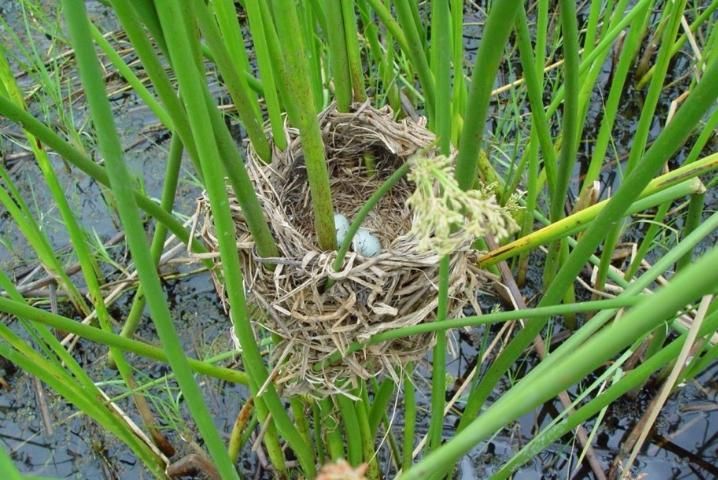
Credit: Mark Hoyer, UF/IFAS
Birds That Prefer Abundant Plants
Many waterfowl, including the American coot (Fulica americana) and ring-necked duck (Aythya collaris), use aquatic plants as a food source and thus are generally more abundant in lakes with an abundance of aquatic plants. Other aquatic birds that prefer a habitat with plentiful aquatic plants include limpkin and pied-billed grebe. These additional species are generalized feeders that consume insects, fish, small animals, snails, and other aquatic fauna that are associated with aquatic vegetation. Wading birds are also often observed walking on and foraging in aquatic plants, including hydrilla, water hyacinths, water lettuce, and native waterlilies, when these plants are present in densities sufficient to support the weight of the birds. If this type of habitat is not available, these birds are restricted to foraging along sparsely vegetated shorelines and mudflats where water is shallow enough to allow wading. Birds in this group prefer lakes with an abundance of aquatic plants; however, these species will often locate and feed in more diverse habitats when their preferred environment is not available.
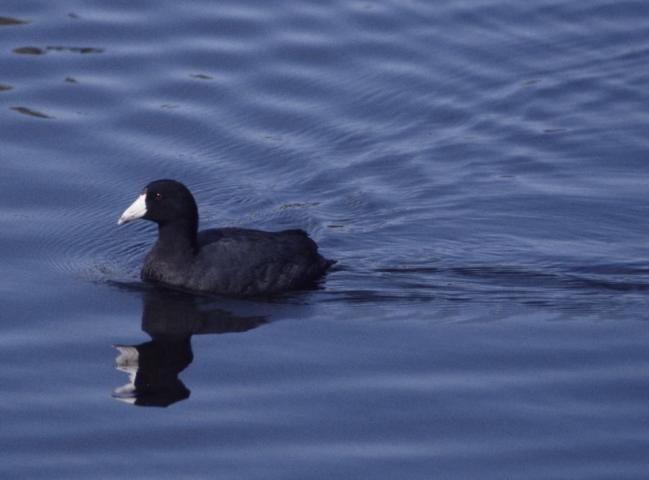
Credit: Lawrence Korhnak
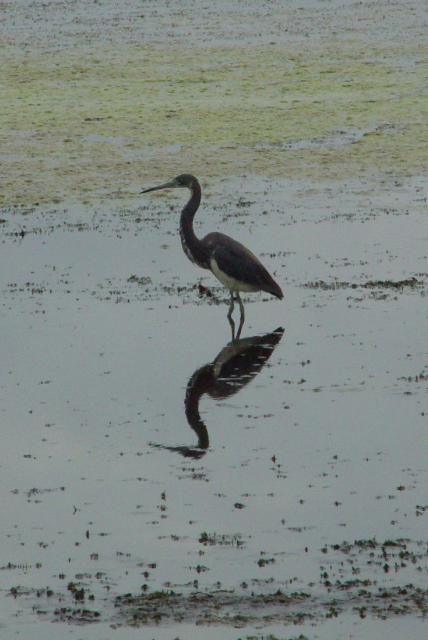
Credit: Mark Hoyer, UF/IFAS
Birds That Prefer Sparse or No Plants
Some bird species, such as anhinga (Anhinga anhinga) and double-crested cormorants (Phalacrocorax auritus), must swim through the water to catch fish, crayfish, frogs and other aquatic fauna. Large amounts of aquatic vegetation interfere with the feeding strategy of these aquatic birds; therefore, this type of bird tends to decrease when submersed aquatic plants become too abundant in a lake.
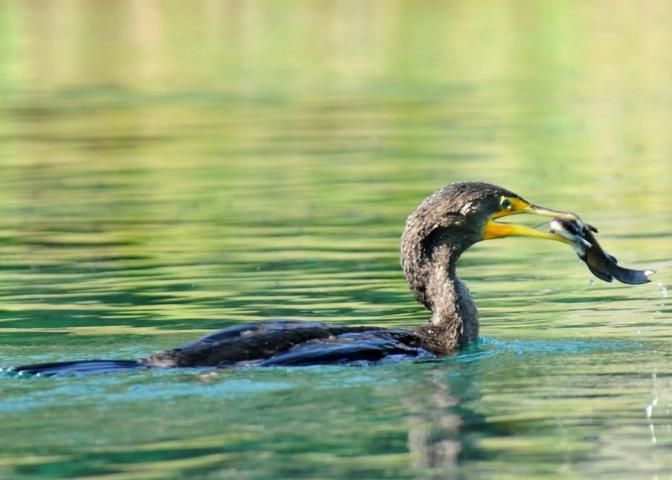
Credit: Lawrence Korhnak
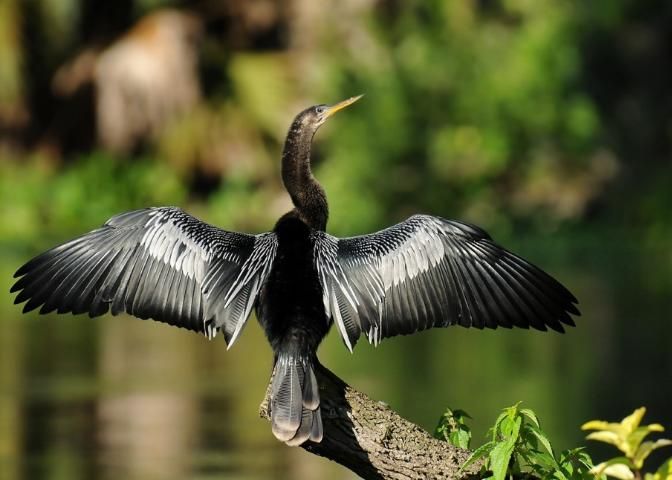
Credit: Lawrence Korhnak.
Some aquatic birds are only affected by certain types of aquatic weeds. For example, bald eagles and ospreys soar over open water in search of fish swimming near the surface of the lake above plants, so submersed aquatic weeds rarely hinder feeding by these species. In fact, because submersed plants reduce wind and wave action and improve water clarity, the presence of these aquatic plants may actually increase the feeding efficiency of sight feeders such as eagles and ospreys. However, dense populations of floating plants and floating-leaved plants (e.g., water hyacinths and waterlilies, etc.) may make foraging difficult for sight-feeding aquatic birds because fish are hidden beneath the vegetation. Sight feeders may be forced to abandon lakes that are heavily vegetated with these types of plants and seek out new water bodies with open water that provide an unobstructed view of their prey.
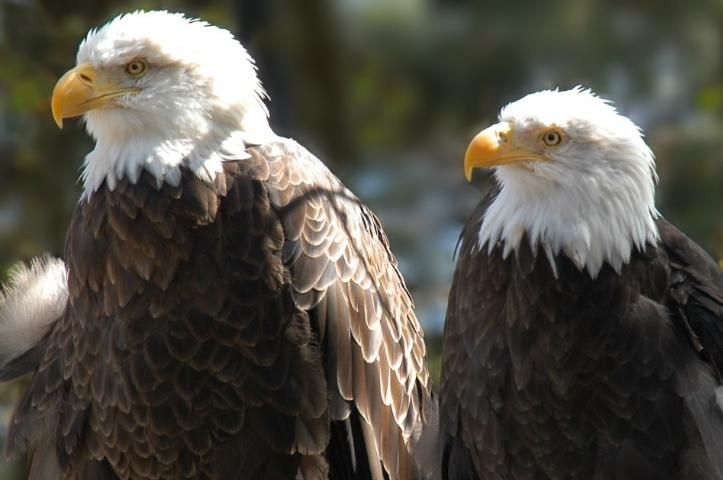
Credit: Lawrence Korhnak
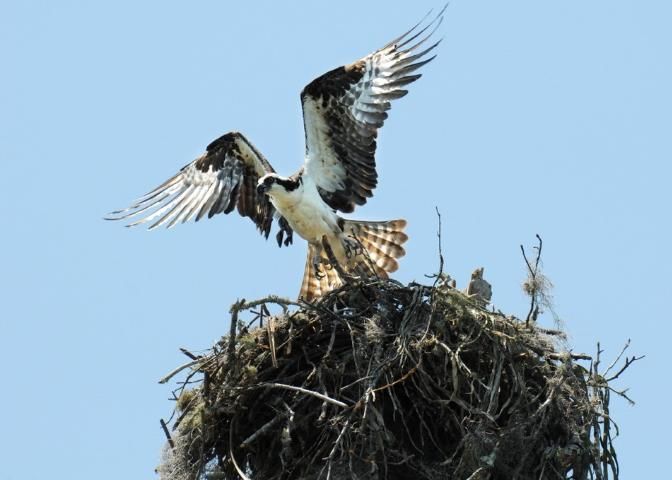
Credit: Lawrence Korhnak
Generalists
Some aquatic bird species, including the secretive American bittern (Botaurus lentiginosus) and least bittern (Ixobrychus exilis), require tall, emergent vegetation like cattails and bulrush for concealment from predators, but the total amount of aquatic vegetation present in the lake does not affect them. When threatened, both species of bittern "freeze" among the reeds with their necks outstretched and bills pointed skyward and sway in imitation of wind-blown emergent vegetation. Even nestling least bitterns, still covered with down, adopt this posture when threatened. Invasion by exotic species of aquatic plants would probably not impact this type of bird unless the exotic plant species reduces the abundance of the required aquatic plant.
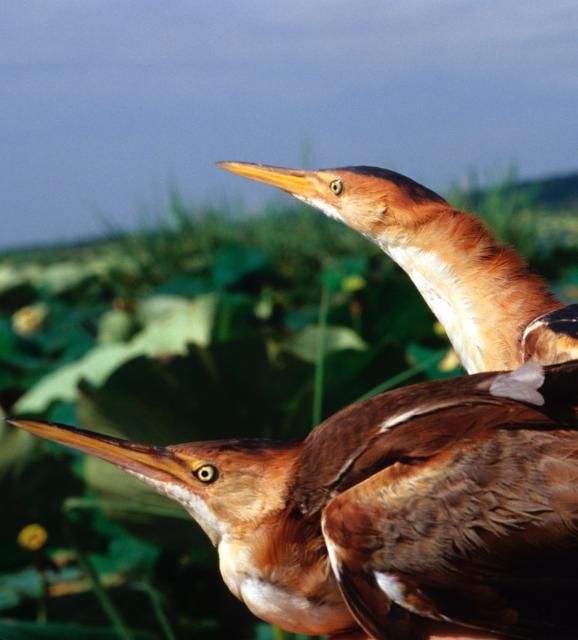
Credit: Mark Hoyer
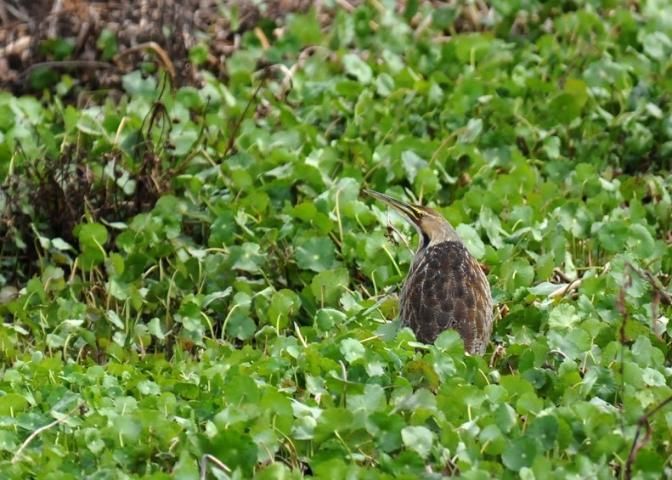
Credit: Lawrence Korhnak
Many wading birds also fall into this group and do well in lakes regardless of the amount of aquatic plants, but one factor that may limit the success of these wading birds is the availability of water shallow enough for them to forage for food. Wading birds that inhabit lakes regardless of the abundance of aquatic plants include great blue heron (Ardea herodias), great egret (Ardea alba), snowy egret (Egretta thula), little blue heron (Egretta caerulea), and tricolored heron (Egretta tricolor). Larger wading birds can forage in water of greater depths, which increases the area available for foraging (Hoyer et al. 2006). Therefore, the great blue heron has an advantage over the smaller little blue heron in open water. However, larger wading birds may become tangled in vegetation when an invasive exotic species covers a lake; on the other hand, many of the smaller wading birds can actually wade on top of dense plant growth, which vastly increases their foraging area.
Seasonal Patterns in Aquatic Bird Abundance (Migration)
Aristotle (c. 384 BCE to 322 BCE) was an ancient Greek philosopher, scientist and natural historian who was first to write about migration as an observable fact. He was an astute observer and, as well as recording the times of departure of some bird species from Greece and listing pelicans, turtle doves, swallows, quail, swans, and geese correctly as migrants, he accurately observed that all migrating birds fatten themselves up before migrating, a fact that was subsequently ignored for 2000 years.
More recently, documented scientific investigation of bird migration began in 1802 when Audubon first began labelling birds with metal leg bands. It was not until the 19th century when large numbers of bands with printed numbers and letters became available that this method really began to deliver results.
Currently, hundreds of thousands of birds are banded around the world each year, both by professionals and amateurs. Over the last few decades, this dedicated work has generated a lot of useful information. This information, in conjunction with that from radar observations and the collection of exhausted and dead birds from buildings such as lighthouses into which they tend to crash, has revealed most of what we know today about bird migration.
Closer to home, because of Florida's subtropical climate, most common aquatic birds can be seen using lakes all year. However, seasonal aquatic bird counts in Florida have identified four general groups of birds related to migration (Hoyer and Canfield 1990; Hoyer et al. 2001). Resident/migrant aquatic bird species can be seen the entire year on lakes but tend to increase in abundance during winter, as northern birds migrate to sunny Florida (e.g., double-crested cormorant, wood duck Aix sponsa). Winter migrant aquatic birds are seen in greater abundance mostly during winter months (e.g., American coot Fulica americana, pied-billed grebe Podilymbus podiceps), especially if it becomes extremely cold in the north. Summer users are aquatic birds that are usually more abundant on lakes only during the summer while nesting and feeding young (Osprey Pandion haliaetus, green-backed heron Butorides striatus). Finally, visitors are birds that are only occasionally seen on individual lakes as they move from lake to lake over the landscape (e.g., wood stork Mycteria americana).
Along with seasonal variability, there can also be considerable annual variability in the abundance of aquatic birds using a lake system. Figure 24 shows the annual variability in the abundance of aquatic birds on Lake Susannah in Orange County, Florida, ranging from a low of about 65 birds/km2 to a high of about 118 birds/km2. It is interesting that the annual abundance of aquatic birds using the lake is inversely related to the amount of rainfall measured in Orange County, Florida. This suggests the possibility that during abundant rainfall many wetlands and ditches are full of water, providing additional habitat for aquatic birds and thus decreasing the use of lake habitats. Conversely, during low-rainfall years, these wetland and ditch habitats dry up, increasing the birds' use of lakes systems. During this same time frame, the annual number of species counted ranged from 8 to 24 a year, showing the large variability that can be encountered when counting aquatic birds on lake systems.

Aquatic/Water Birds—Summary
Aquatic birds come in an array of sizes and shapes and require many different resources to complete their life cycles. A few generalizations can be made regarding groups of similar bird types, but all species are somewhat different. Also, individual species are adaptable and often able to use available resources even if those resources may not be preferred. Nutrient management and encroachment/management of invasive aquatic plants can increase, decrease, or have little to no impact on a particular aquatic bird species, which makes it difficult to predict the impact of lake management efforts on a given bird species. This dilemma becomes even more challenging when you consider that birds fly, and thus they can easily travel from lake to lake to find the habitat that best suits their needs, even though the distance may seem prohibitive to us.
Common Aquatic/Water Birds Using Florida Lakes
LAKEWATCH aquatic bird surveys have been conducted since the early 1990s; however, the surveys were standardized in 2000. Thus, the data used in this section of the circular started in 2000. Since 2000, Florida LAKEWATCH's citizen scientists have conducted 905 aquatic bird surveys on 114 lakes (Table 1) from 24 Florida counties ranging from the Panhandle (Walton County) to south Florida (Miami-Dade County). Some lakes were counted for multiple years (up to 17) while some lakes were only counted for one year. There were 30 lakes having surveys conducted in five separate years. In total, volunteers counted over 220,000 aquatic birds. Well done, citizen scientists!
There were 50 species of aquatic birds counted at three or more lakes. For this circular, these 50 species were considered the common aquatic birds using Florida lakes. These species and the total number of lakes on which an individual species was observed are provided in Table 1. The most commonly observed species throughout LAKEWATCH's aquatic bird surveys were the anhinga and the great blue heron, observed on 101 and 100 lakes, respectively. Only five rare species were identified during the LAKEWATCH surveys, and they include: black-bellied whistling-duck Dendrocygna autumnalis, black-necked stilt Himantopus mexicanus, greater yellowlegs Tringa melanoleuca, lesser yellowlegs Tringa solitaria, and least tern Sterna antillarum. They were each observed on only three lakes. Table 1 also provides the average length and weight of each aquatic bird species to be used as a reference when trying to identify birds in the field.
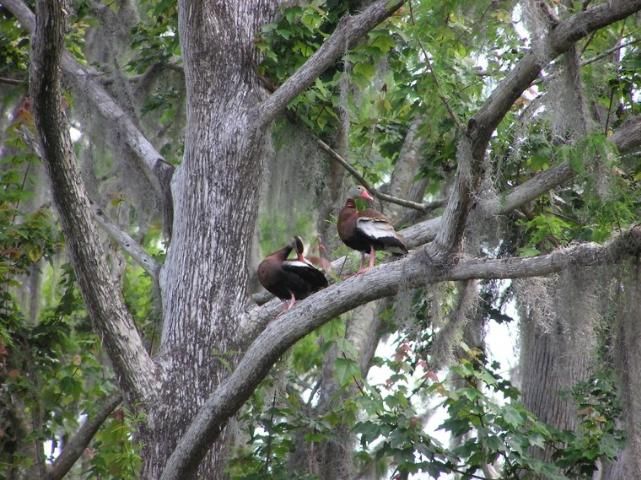
Credit: Mark Hoyer, UF/IFAS
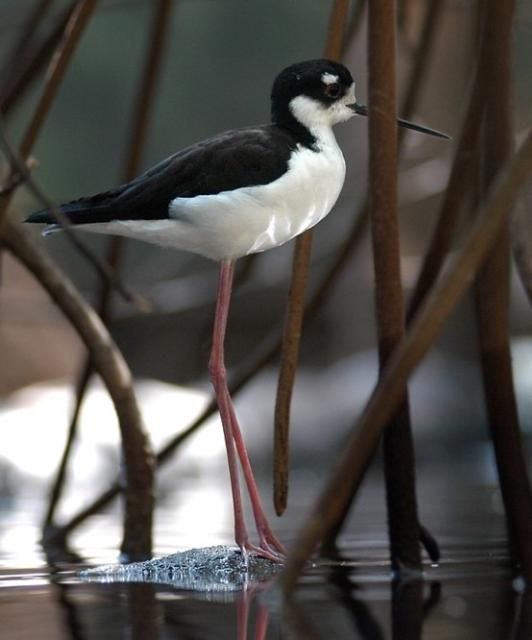
Credit: Lawrence Korhnak
The corresponding water chemistry (Table 2) for each of the lakes upon which birds were counted was collected and analyzed using Florida LAKEWATCH's standard operating procedures (https://lakewatch.ifas.ufl.edu/media/lakewatchifasufledu/for-volunteers/LAKEWATCH_SOP-Updated-6-22-2020-MVH2.docx). The lakes that have been part of the Florida LAKEWATCH aquatic bird program cover the variability of most Florida lakes ranging from oligotrophic to hypereutrophic with chlorophyll values averaging 25µg/L and ranging from 1.4 µg/L to 155 µg/L (Table 2). The true color of the lakes averaged 51 Pt-Co units with lakes ranging from clearwater (2.3 Pt-Co units) to highly colored lakes (487 Pt-Co units). Specific conductance in the lakes averaged 223 µS/cm @ 25°C and ranged from water low in dissolved salts (21 µS) to water rich in dissolved salts (3,186 µS). Bird density averaged 272 birds/km2 and ranged from 0.4 birds/km2 to 3,350 birds/km2 (Table 2). Birds counted per hour of observation averaged 127 birds/hr, ranging from 1 bird/hr to 4,020 birds/hr. Similar to research reported above the total abundance of aquatic birds counted during LAKEWATCH's aquatic bird surveys increased as the lake trophic state increased (Figure 27).
Lake area data were only available for 81 lakes, and those ranged from 1 acre to over 16,000 acres, or 0.4 ha to over 6,600 ha. Mean depth and aquatic plant data were available for only 44 lakes. Mean depth averaged 9.5 ft (1.1 m), ranging 3.6 ft (1.1 m) to 32.1 ft (9.8 m). Aquatic plant abundance, percent area covered (PAC) and percent volume infested or inhabited (PVI) with aquatic plants averaged 41% (Range 0% to 100%) and 13% (Range 0% to 100%), respectively.
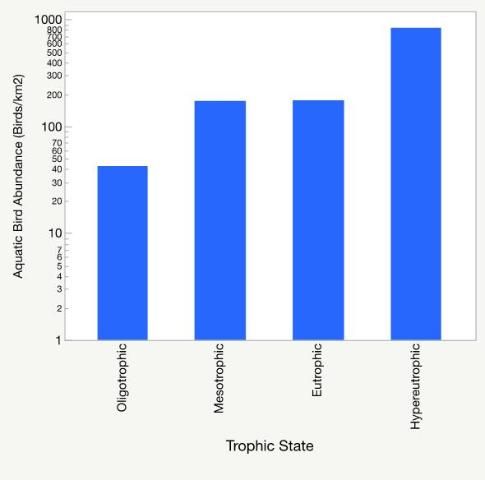
Credit: Lake trophic state was determined using lake average chlorophyll values and the classification system of Forsberg and Ryding (1980).
Some individual aquatic plant and fish species have been shown to survive/occupy lakes with specific water chemistries, while others can be found in lakes with a wide range of chemistries. For example, lined topminnow (Fundulus lineolatus) and redfin pickerel (Esox americanus) are found most often in softwater lakes (softwater = specific conductance < 100 µS/cm@25°C and hardwater = specific conductance > 100 µS/cm@25°C) while gizzard shad (Dorosoma cepedianum) and threadfin shad (Dorosoma petenense) are most often found in hardwater systems (Hoyer and Canfield 1994b). Water shield (Brasenia schreberi) and spider-grass (Websteria confervoides) are found most often in softwater lakes while eelgrass (Vallisineria americana) and Illinois pondweed (Potamogeton illinoensis) are most often found in hardwater lakes (Hoyer et al. 1996).
Similarly, Figures 28 through 31 show that some bird species are also found more often in lakes with specific water chemistries and different abundances of aquatic plants. Reddish egret (Egretta rufescens) and common snipe (Gallinago gallinago) were found on softwater lakes while roseate spoonbill (Ajaia ajaja) and black-necked stilt (Himantopus mexicanus) were found mostly in hardwater lakes (Figure 28). Similar species affiliations to water chemistry can be found for lake trophic state (Figure 29), true color (Figure 30), and aquatic plant abundances (Figure 31).
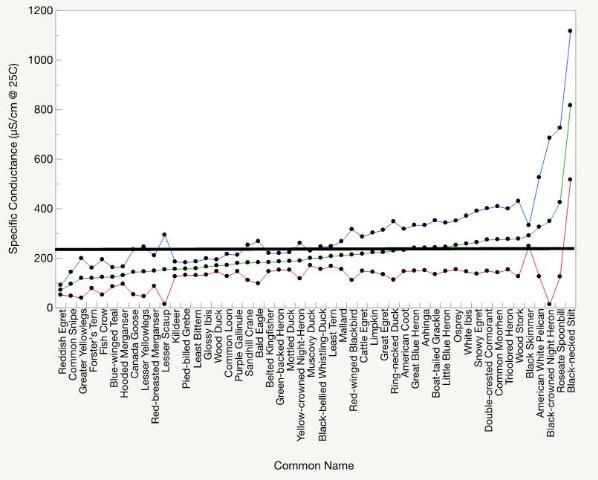
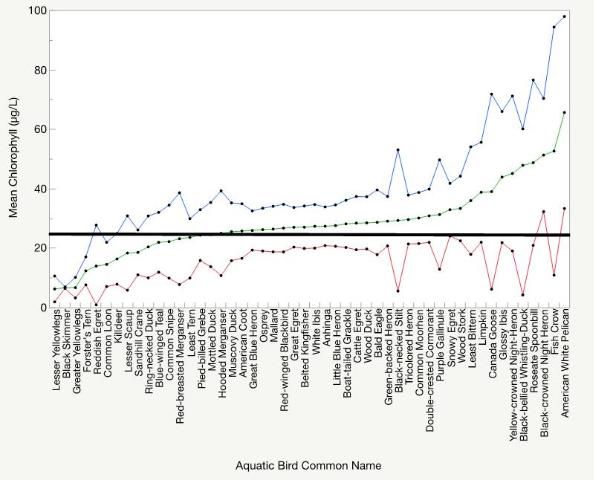
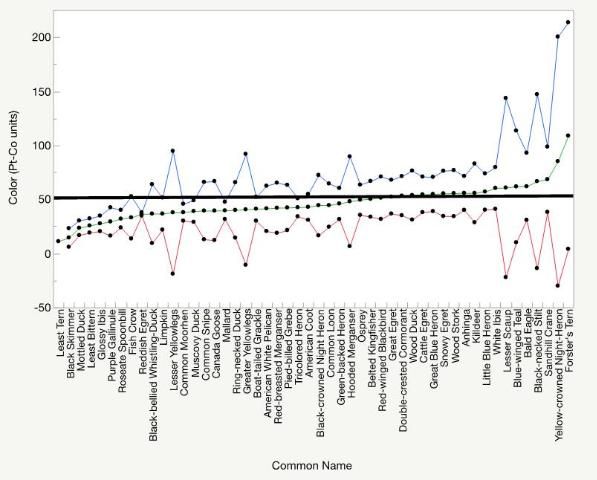
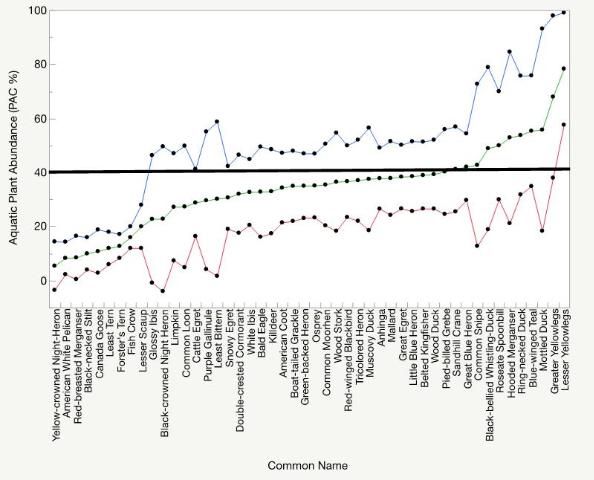
Table 3 is excerpted from The Birder's Handbook—A Field Guide to the Natural History of North American Birds (Ehrlich et al. 1988). The handbook provides complete life history information for all North American birds, but to keep the table from becoming impracticably large and unwieldy, we have limited our focus to just four aspects of bird life history: nest location, nest type, diet, and foraging. These four are more than sufficient to reveal the diversity and uniqueness of these common aquatic birds. The birds generally use six different nest locations, six different nest types, eight different diets, and ten different methods of foraging to obtain food items, all of which variety shows why it is extremely hard to make sweeping statements about how management decisions made for a given lake could impact the aquatic birds using that lake. As the table reveals, each of the species has its own unique life history, complicating the task of lake management and underscoring the importance of citizen-science contributions to our understanding of the complex interactions between birds and lakes.
Becoming a Serious Birder—and Perhaps a Citizen Scientist?
Many people throughout the world enjoy watching and researching birds. Because of that, there are many different resources that cover thousands of different bird species and in much greater detail than this information circular featuring just 50 aquatic birds commonly found in Florida. For serious birders, Ehrlich et al. (1988) The Birder's Handbook describes complete life history information on all North American birds. The guidebooks described in an earlier section, National Geographic's Field Guide to the Birds of North America and Roger Tory Peterson's classic A Field Guide to the Birds East of the Rockies, can help in the field, and one or more of the electronic guides also listed in that section will quickly become essential aides, especially when you're learning to identify birds by their calls. The Literature Cited section at the end of the circular offers more resources.
We hope this information circular will prove useful to readers interested in learning about the aquatic birds that use Florida lakes and how they relate to the ecology of Florida lakes. If you want to explore further and think you may be interested in joining other birders all over Florida to participate in the citizen science effort to better understand birds and lakes and their interactions, please consider contacting LAKEWATCH.
Literature Cited
Butcher, G. S. 1990. "Audubon Christmas Bird Counts." In Survey Designs and Statistical Methods for the Estimation of Avian Population Trends. Biological Report 90(1), edited by J. R. Sauer and S. Droege, 5–13. Washington DC: Fish and Wildlife Service, US Department of Interior.
Dunning, J. B. 2008. CRC Handbook of Avian Body Mass. Second edition. Boca Raton, FL: CRC Press, Taylor and Francis Group.
Ehrlich, P. R., D. S. Dobkin, and D. Wheye. 1988. The Birders Handbook: A Field Guide to the Natural History of North American Birds. New York: Simon and Schuster Inc.
Forsberg, C., and S. O. Ryding. 1980. "Eutrophication parameters and trophic state indices in 30 Swedish waste-receiving lakes." Arch. Hydrobiol. 89: 189–207.
Hanson, A. R., and J. J. Kerekes. 2006. "Limnology and Aquatic Birds." Proceedings of the Fourth Conference Working Group on Aquatic Birds of Societas Internationalis Limnologiae (SIL). Dordrecht, The Netherlands: Springer.
Hoyer, M. V., D. L. Bigham, R. W. Bachmann, and D. E. Canfield Jr. 2014. "Florida LAKEWATCH: Citizen Scientists protecting Florida's aquatic systems." Florida Scientist 77: 184–197.
Hoyer, M. V., and D. E. Canfield Jr. 1990. "Limnological factors influencing bird abundance and species richness on Florida lakes." Lake and Reservoir Management 6: 133–141.
Hoyer, M. V., and D. E. Canfield Jr. 1994a. "Bird abundance and species richness on Florida lakes: Influence of lake trophic status, morphology, and aquatic macrophytes." Hydrobiologia 297/280: 107–119.
Hoyer, M. V., and D. E. Canfield Jr. 1994b. Handbook of Common Freshwater Fish in Florida Lakes. SP160. Gainesville: University of Florida Institute of Food and Agricultural Sciences.
Hoyer, M. V., D. E. Canfield Jr., C. A. Horsburgh, and K. Brown. 1996. Florida Freshwater Plants—a Handbook of Common Aquatic Plants in Florida Lakes. SP 189. Gainesville: University of Florida Institute of Food and Agricultural Sciences.
Hoyer, M. V., S. K. Notestein, T. K. Frazer, and D. E. Canfield Jr. 2006. "Bird density, biomass, and species richness on five Florida coastal rivers, with comparisons to Florida lakes." Hydrobiologia 567: 5–18.
Hoyer, M. V., N. Wellendorf, R. Frydenborg, D. Bartlett, and D. E. Canfield Jr. 2012. "A comparison between professionally (Florida Department of Environmental Protection) and volunteer (Florida LAKEWATCH) collected trophic state chemistry data in Florida." Lake Reservoir Management 28: 277–281.
Hoyer, M. V., J. Winn, and D. E. Canfield Jr. 2001. "Citizen monitoring of aquatic bird populations using a Florida lake." Lake and Reservoir Management 17: 82–89.
Kerekes, J. J., and B. Pollard (eds.). 1994. "Symposium proceedings: aquatic birds in the trophic web of lakes." Sackville, New Brunswick, Canada. Aug. 19–22, 1991. Developments in Hydrobiology, vol. 96. Reprinted from Hydrobiologia vol. 279/280.
Leeper, D., M. Kelley, A. Munson, and R. Grant. 2001. "A Multiple-Parameter Approach for Establishing Minimum Levels for Category 3 Lakes of the Southwest Florida Water Management District." Final Report, Southwest Florida Water Management, Brooksville, FL 34604-6899
National Geographic Society. 1983. National Geographic Field Guide to the Birds of North America. Washington, D.C.
Newson, S. E., R. J. W. Woodburn, D. G. Noble, S. R. Baillie, and R. D. Gregory. 2005. "Evaluating the Breeding Bird Survey for Producing National Population Size and Density Estimates." Bird Study 52: 42–54.
Peterson, R. T. 1980. A Field Guide to the Birds East of the Rockies. Fourth edition. Boston: Houghton Mifflin Company.
Statistical Analysis Software. 2000. JMP 14.0. SAS Institute Inc. Cary, NC.
Terres, J. K. 1980. The Audubon Society Encyclopedia of North American Birds. New York: Alfred A. Knopf.
List of common aquatic birds identified using Florida lakes and the number of lakes on which each species was identified. The length (in and m) and weights (lb and kg) of each species are listed to give a general idea of size for those just getting started watching aquatic birds. The average lengths were calculated from those listed in National Geographic Society Field Guide to Birds of North America (National Geographic Society 1983), and the average weights were calculated from those listed in CRC Handbook of Avian Body Masses (Dunning 2008).
Summary statistics for aquatic bird surveys conducted by Florida LAKEWATCH, including the number of lakes with available data and mean, minimum, and maximum data for each available variable.